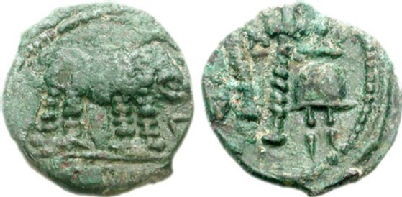All 1 entries tagged Aulus Hirtius
No other Warwick Blogs use the tag Aulus Hirtius on entries | View entries tagged Aulus Hirtius at Technorati | There are no images tagged Aulus Hirtius on this blog
August 01, 2013
A bronze coin struck by Aulus Hirtius in Gaul, 45 BC (RPC 501)
Coin of the Month, October 2012
 In 49 BC Julius Caesar struck a coin series in his name showing an elephant trampling a snake on one side, and the emblems of his position as chief priest of Rome on the other. Scholarship remains divided on what Caesar meant by the elephant and snake imagery, but, having robbed the state treasury in Rome, Caesar was able to mint one of the largest issues of coinage that Rome had ever seen. Four years later a supporter of Caesar, Aulus Hirtius, struck coinage showing exactly the same imagery, replacing Caesar's name with his own. Hirtius also added an eigth book to Caesar's account of his Gallic Wars, and played a key role in the civil wars that followed Julius Caesar's assassination. This particular coin is significant since it demonstrates that the imagery Caesar chose for his coinage was viewed, remembered,and then redeployed in different contexts. Here Hirtius uses the imagery to underline his connection to the Caesarian cause. It is evident that Roman coins were 'monuments in miniature', intended to communicate ideologies as well as to serve as a means of payment and exchange. The image of the elephant and the snake was later adopted as a symbol of Roman power in Gaul and Africa. The iconography of Julius Caesar was transformed into an imagery of Empire. (To see the original coin of Julius Caesar, click here
In 49 BC Julius Caesar struck a coin series in his name showing an elephant trampling a snake on one side, and the emblems of his position as chief priest of Rome on the other. Scholarship remains divided on what Caesar meant by the elephant and snake imagery, but, having robbed the state treasury in Rome, Caesar was able to mint one of the largest issues of coinage that Rome had ever seen. Four years later a supporter of Caesar, Aulus Hirtius, struck coinage showing exactly the same imagery, replacing Caesar's name with his own. Hirtius also added an eigth book to Caesar's account of his Gallic Wars, and played a key role in the civil wars that followed Julius Caesar's assassination. This particular coin is significant since it demonstrates that the imagery Caesar chose for his coinage was viewed, remembered,and then redeployed in different contexts. Here Hirtius uses the imagery to underline his connection to the Caesarian cause. It is evident that Roman coins were 'monuments in miniature', intended to communicate ideologies as well as to serve as a means of payment and exchange. The image of the elephant and the snake was later adopted as a symbol of Roman power in Gaul and Africa. The iconography of Julius Caesar was transformed into an imagery of Empire. (To see the original coin of Julius Caesar, click here .)
.)
 This month's coin was chosen by Clare Rowan, a research fellow in Numismatics at Warwick. As part of her research, Clare works on how coinage was used as a medium to visualise and negotiate Roman power in the provinces of the Republic. By looking at coin iconography in the Roman provinces, we are able to reconstruct how Roman control of particular regions was viewed, negogiated or rejected. Click here
This month's coin was chosen by Clare Rowan, a research fellow in Numismatics at Warwick. As part of her research, Clare works on how coinage was used as a medium to visualise and negotiate Roman power in the provinces of the Republic. By looking at coin iconography in the Roman provinces, we are able to reconstruct how Roman control of particular regions was viewed, negogiated or rejected. Click here for more information.
for more information.
(Coin image reproduced courtesy of Classical Numismatic Group, Inc; http://www.cngcoins.com)
 Clare Rowan
Clare Rowan

 Please wait - comments are loading
Please wait - comments are loading

 Loading…
Loading…

